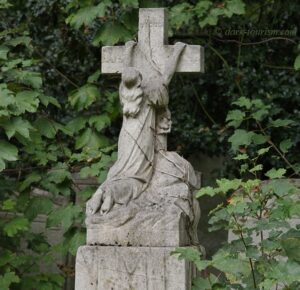The topic of this blog post was decided by the most recent theme poll, where it sailed to a clear victory over all the other options by a huge margin (as reported in last Sunday’s newsletter). So here we go.
As a couple of commentators noted, the word ‘bars’ is of course lexically ambiguous, and exploiting that double meaning had been my intention all along. So let’s begin with the darker side of bars – those you sit behind in prisons and similar institutions.
The first photo shows the cell – behind bars both on the window and the cell door – of the most prominent inmate that the prison on Robben Island ever had: Nelson Mandela.
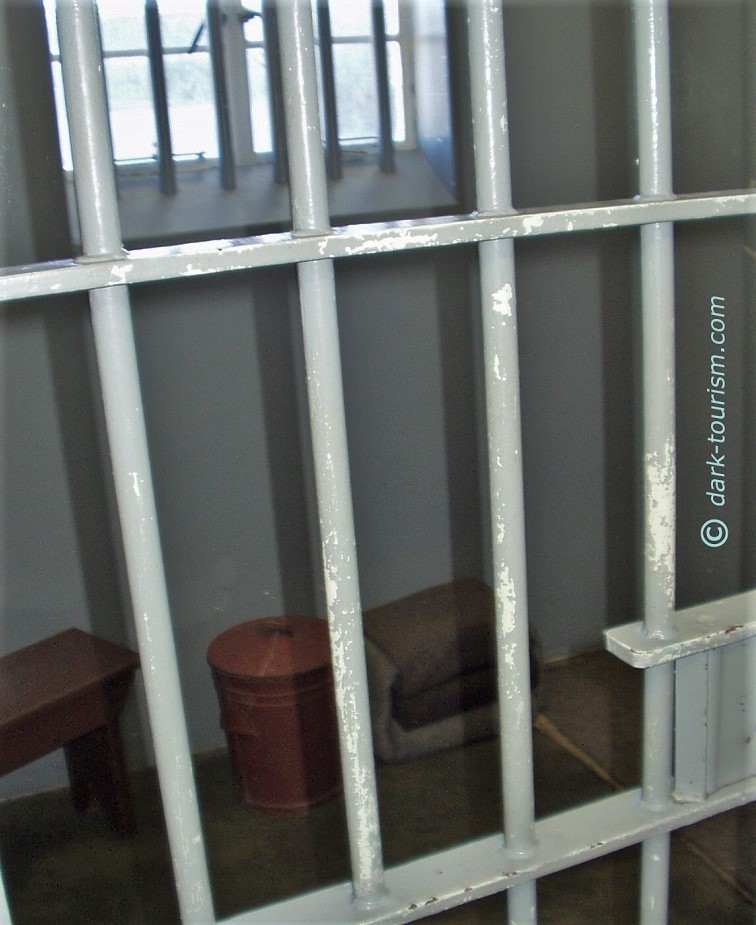
Mandela spent 18 out of the total 27 years he was imprisoned on Robben Island, which is a speck of land in Table Bay outside Cape Town in South Africa. The high-security prison closed for good in 1996, after the end of apartheid, and has since become one of the key (dark) tourist attractions of Cape Town. It’s a long time since I went there, back in 2002, but I still remember well how impressed I was with the guide, an ex-prisoner from the anti-apartheid movement, who, despite his experience, was very gentle and without hard feelings.
The next photo shows barred cells in one of the world’s most infamous and legendary prisons: Alcatraz, also a prison island, in the Bay of San Francisco, USA.
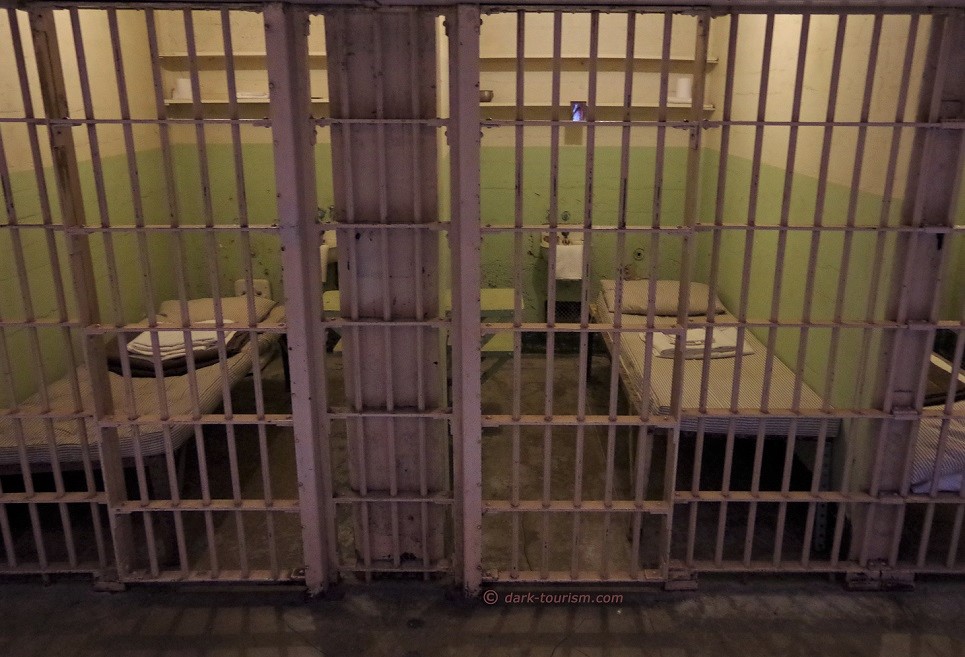
Like Robben Island, Alcatraz has become a major tourist attraction, visited by so many people that you have to book tickets online ahead of time in order to guarantee you get a place (they often sell out way in advance). In some areas, especially the main cell tract, visited with an audio-guide, it can hence get rather crowded. The legend of Alcatraz certainly lives on.
In contrast, the bars in the next photo are in a prison that most readers will probably never have heard of: the EL-DE Haus in Cologne, Germany:
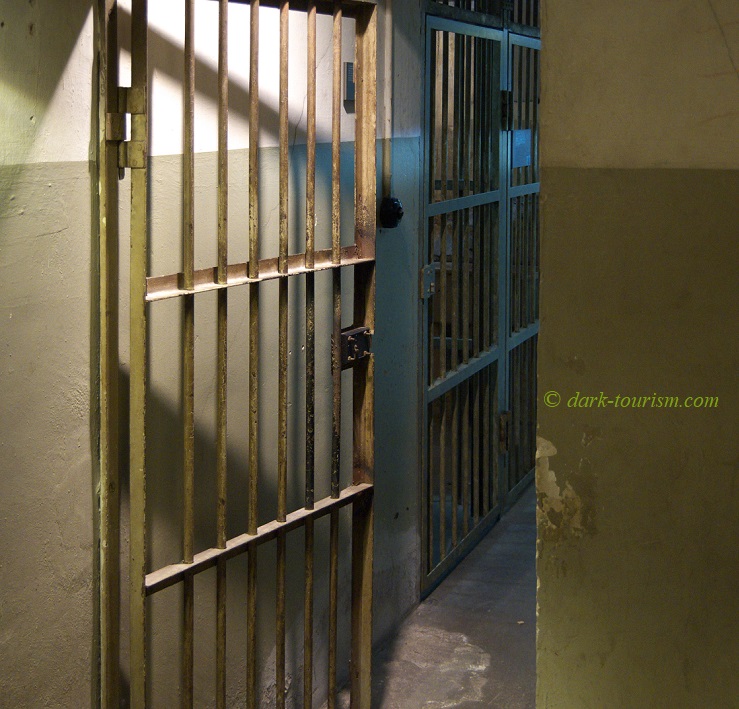
This was the city’s Gestapo HQ during the Third Reich, and the basement was the prison of this infamous secret police. The building survived the war (while 95% of the rest of the inner city was bombed flat during WWII), but it took a long campaign before the basement prison was turned into a memorial in 1981. The upper storeys are home to an ‘NS documentation centre’.
Another feared secret service police was the Stasi in communist East Germany (the GDR) until the demise of that state in 1989/1990. Several of their former prisons and command centres have since been turned into memorial sites too. This photo, shot through the bars, or rather mesh fence, from the upper level, shows the main cell tract of the former remand prison of the Stasi at Bautzner Straße in Dresden.
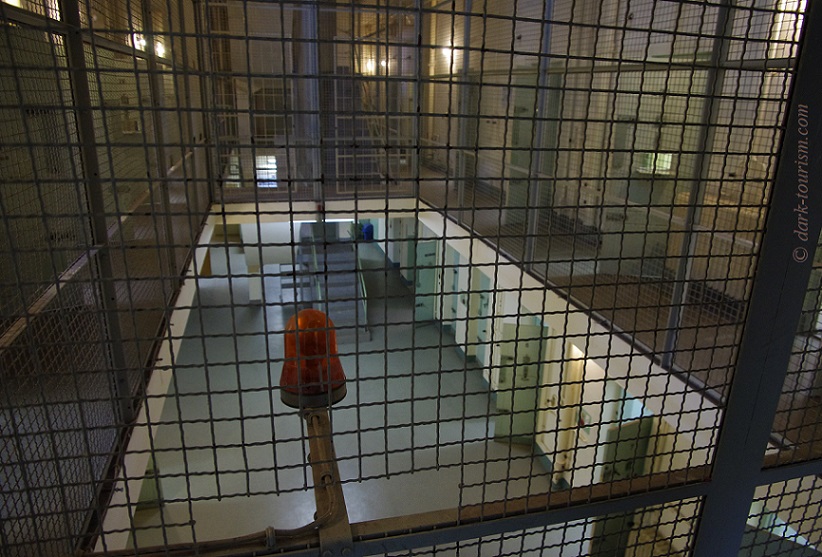
What the Stasi was to the GDR, the KGB was to the Soviet Union – and several former KGB prisons have also been turned into memorials. This photo was taken inside the ex-KGB prison in Potsdam outside Berlin.
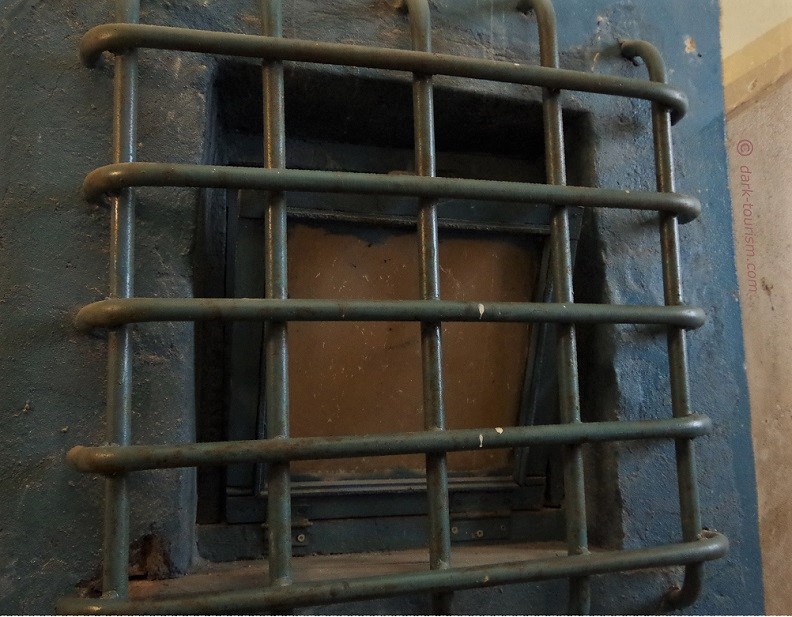
The following photo shows the barred door that blocks the way up to what was the Platterhof at Obersalzberg in Bavaria, Germany.
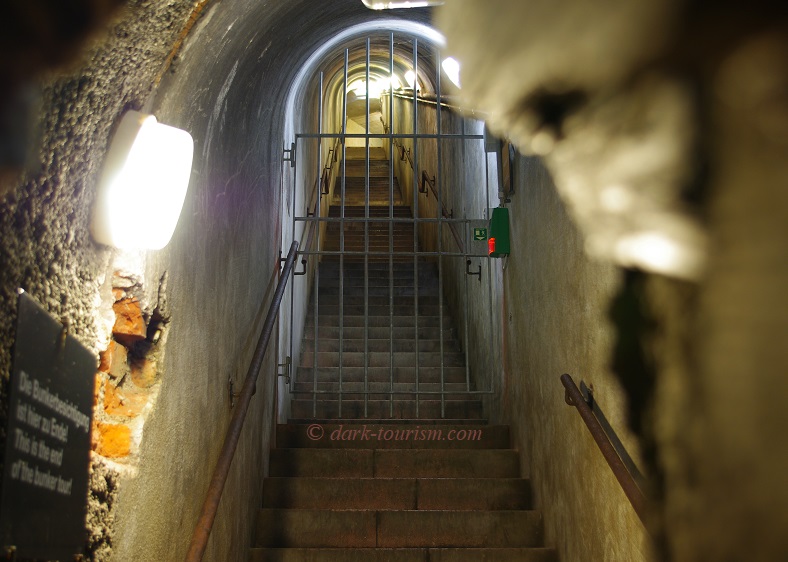
It’s at the end of the tunnels made accessible by the Documentation Centre Obersalzberg, whose exhibition chronicles the history and role of this complex of Nazi homes and barracks in what was Adolf Hitler’s favourite part of Germany (and he could get a view into his native Austria from here too). His mansion, the Berghof, did not survive the war and subsequent destruction, and the Platterhof, used as a hotel by the US military until they moved out in the 1990s was demolished in 2000/2001. But a nearby former Nazi guest house did survive and now houses the main part of the Documentation Centre’s exhibition. The bunkers and tunnels underneath the former Platterhof were renovated and opened to the public. The site is currently undergoing a substantial expansion.
But so much for bars in the sense of steel bars preventing movement/escape, and onwards to what I guess many readers will have been waiting for … so, let’s go to the bar, in the sense of a place to have a drink in! … if only virtually.
The first photo in that theme shows a sign directing visitors to a bar in remote Barentsburg, a Russian coal-mining settlement on Spitsbergen, Svalbard, in the high Arctic.
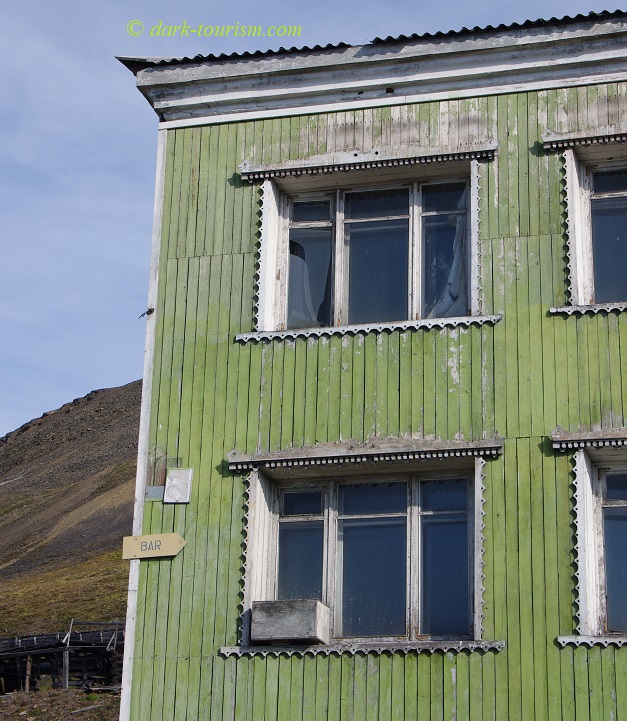
Svalbard is a territory administered by Norway, but since early treaties signed in the 1920s, the Soviet Union, and later Russia, retained mining rights on the island of Spitsbergen, even during the Cold War, when the USSR belonged to the Warsaw Pact and Norway was, and still is, part of NATO, i.e. nominally the Soviets’ enemy. But the Svalbard Treaty also stipulated that the islands remain de-militarized, so there was no confrontation, just peaceful coexistence. Quite an oddity of the Cold War era! These days you can go and visit Barentsburg by boat (or snowmobile in winter) from the capital Longyearbyen and go on a tour led by Russian guides (who speak English, though).
But now for a proper bar interior. The next photo was taken in the Kentucky Bar in Juarez in Mexico, a city on the border river Rio Grande opposite El Paso, Texas, USA.
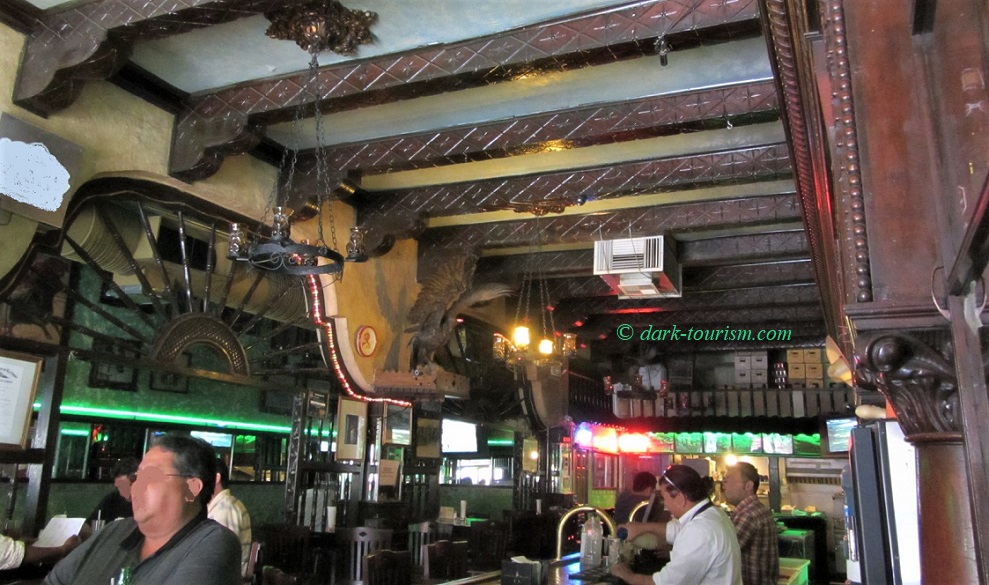
In the Prohibition era, a lot of alcohol production was moved to Mexico, where familiar US brands continued to be made for export, as well as for illegal “import” into the USA. The Kentucky Bar today has several antique bottles from that time on display. Oh, and another thing: this place lays claim to having invented the Margarita cocktail. But you may ask: what is dark about this, other than the link to the Prohibition era and smuggling crime? Well, at the time I went there, on foot walking across the border bridge from El Paso, Juarez had a very dark reputation, namely as the “murder capital” of Mexico (if not the world). But my visit was on a Sunday afternoon, and I didn’t venture far from the main street leading away from the border. So it was fairly safe. As for the border crossing: while getting into Mexico was a piece of cake, getting back into the US was a lengthier affair, as we had to queue up with the Mexicans, while US citizens had a fast lane for themselves. The border security officer was very friendly, though, and when he asked what we had crossed into Mexico for and we answered “to go to the bar where the Margarita was invented” he grinned and asked back “And? Was it good?” We affirmed this and after a quick check of our passports and ESTA visa-waiver forms we were let through. It was one of my shortest visits to a new country ever, only just over half an hour. But I’d quite like to go to Mexico properly one day and explore it for real.
The next bar I can give you a photo from is the Goldene Bar in Munich, Germany. Here the dark link is that the place goes back to the Nazi era. The bar is part of the Haus der Kunst, one of the earliest representational and monumental pieces of Nazi architecture.
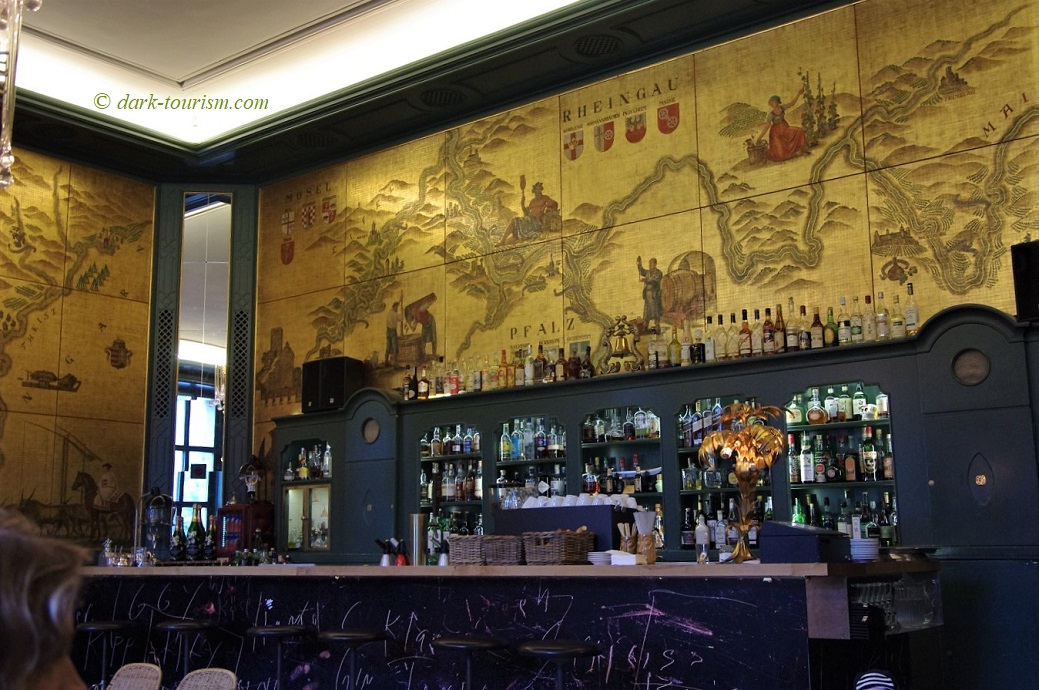
The walls of this bar were decorated with images hand-painted on gold leaf (hence the name, ‘golden bar’) that depict thematic scenes from around the world: vineyards, whisky distilleries, tobacco harvests and so on. This was to provide an international flair on the theme of what is served in a bar, while masking the ultimately racist and anti-international ideology of the Nazis. The building, and the bar, survived WWII, and both reopened, but the bar’s original wall decorations were initially hidden, until they were restored in the early 2000s.
The next bar (also featured as the lead photo above) is a little oddity here, and with quite a special story attached to it:
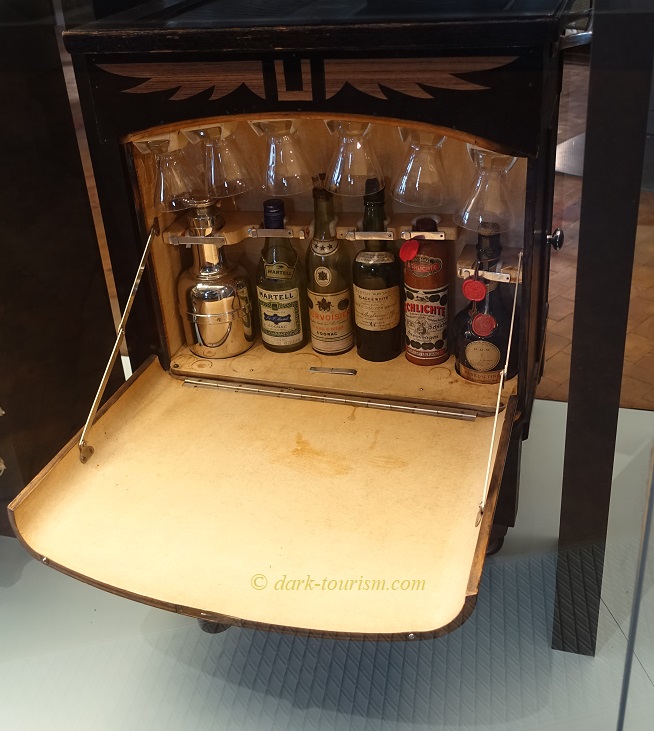
This was the on-board bar cabinet of Ernst Udet which he had inside his aeroplane and which is now on display at the German Technikmuseum in Berlin.
Ernst Udet was a World War One flying ace, inter-war-years air-show performer and playboy, and joined the Nazis in 1933, despite being unpolitical, after being promised by Hermann Göring that he could have a role in developing the Luftwaffe (which he did help with, especially on the design of the Ju-87 Stuka). However, Udet despised the bureaucratic aspects of his job and increasingly turned to alcohol, while also getting disenchanted with his Nazi superiors. He had been on an inspection trip to the USSR to assess the strength of the Soviet air force, which he deemed very strong, but that assessment was withheld from Hitler by Göring. Udet’s alcoholism and psychological decline increased in the course of 1941 and after the Wehrmacht had launched Operation Barbarossa (the invasion of the USSR) in June, he committed suicide by shooting himself in the head. His grave can be found next to Manfred von Richthofen’s in the Invalidenfriedhof cemetery in Berlin.
The next bar coming up is actually a reconstruction, namely at Bletchley Park in Great Britain, home of the fabled code-breakers, especially the legendary Alan Turing, who managed to decipher the Nazi military’s Enigma machine (and subsequently further such systems) and thus made a major contribution to the Allies’ victory in WWII.
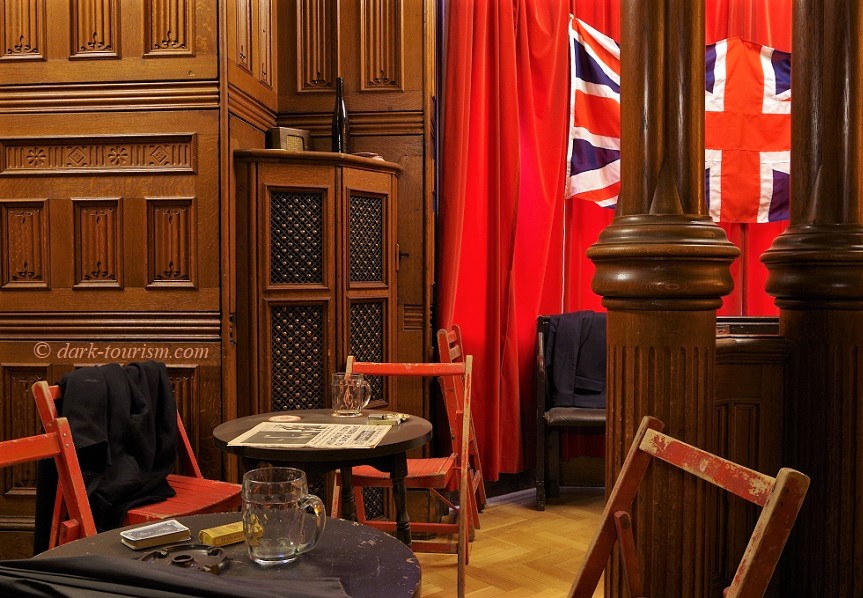
Bletchley Park today is a vast museum complex (you need two days to cover everything), and I saw this bar in the section that was about the movie “The Imitation Game”, which tells the story of the efforts of Bletchley Park and the role of Alan Turing in it. So I guess it’s just a film prop, not a genuine bar.
So, we’ve had Nazi bars and a British one, time for a Soviet one. Here’s the mock Georgian wine tavern at Stalin’s bunker in Moscow:
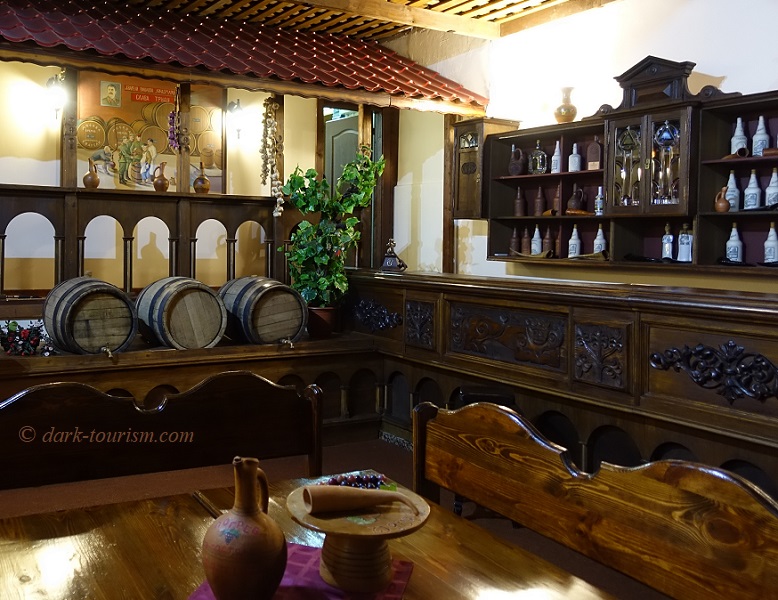
I saw this as part of a specially arranged tour of Stalin’s old bunker out at the Izmailovo sports stadium. On the tour the guide claimed that the location was chosen because Stalin deemed it safe, insofar as the Nazis would need such sports facilities to put on their own propaganda shows if they won and hence would spare them from being bombed. Whether that’s true or just a myth I can’t say, though. Anyway, the large wine tavern and adjacent rooms can these days also be hired for private parties and such events. How contemporary Russian is that! I can well imagine some wealthy oligarchs boasting about throwing a party in Stalin’s very own bunker.
Staying within the Soviet sphere for a bit longer, here’s one that used to be a so-called “Valuta Bar” in a hotel built for foreign visitors, namely the former Intourist Hotel in Tallinn, Estonia.
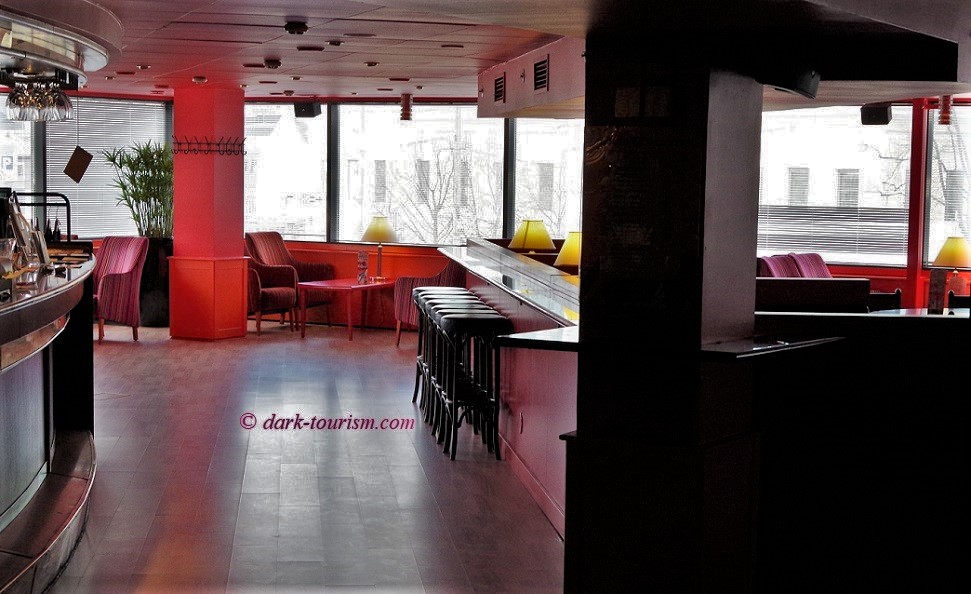
The hotel, including the restaurant and bar, was heavily bugged by the KGB during Soviet times, as they were keen to overhear everything the foreigners might be talking about. After the collapse of the USSR, the hidden KGB surveillance room on a secret extra floor of the hotel was discovered, and this is now a KGB Museum of sorts, visitable on guided tours. While the rest of the hotel has been thoroughly refurbished and modernized and so no longer has that Soviet atmosphere, the bar retains some interior designs from that period … and the name, Valuta Bar, also goes back to that era. “Valuta” means foreign currency, so this was one of those bars for foreigners only where no roubles were accepted, just dollars, pounds, marks, francs, etc. … Today, of course, you pay in euros.
And here’s one more from the realm of communism, namely from Brioni (or “Brijuni” in the local spelling), the former private Croatian island resort of ex-Yugoslavia’s leader Tito.
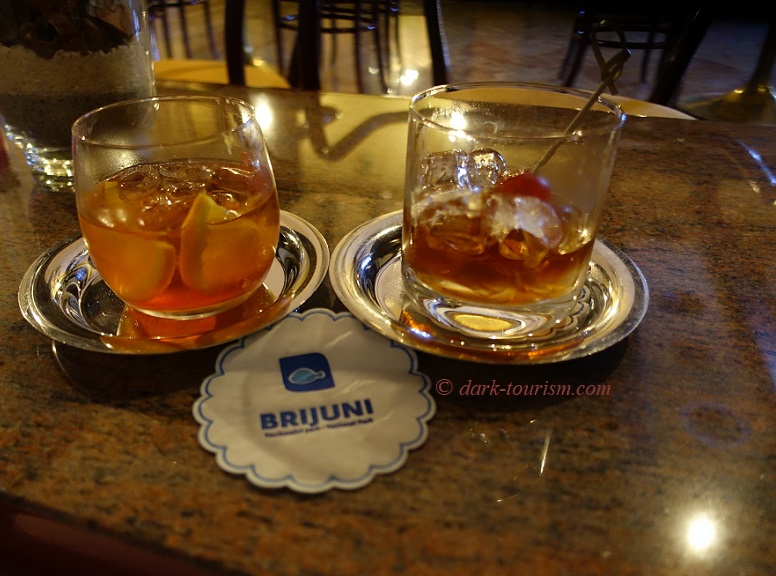
The cocktails were, if memory serves me right, a Manhattan and a Negroni. Brioni has become a rather mainstream visitor attraction, and many people go there by boat on day trips and just wander around for a few hours to take in the scenery. But you can also stay overnight in what was Tito’s guest house. His former private residence is off limits, though. However, there is a dedicated museum about “Tito on Brioni”, which is full of unashamedly cult-of-personality hero worship.
At the other end of the extremes, here’s one related to a right-wing military dictatorship, namely that of Augusto Pinochet in Chile from 1973 to 1990.
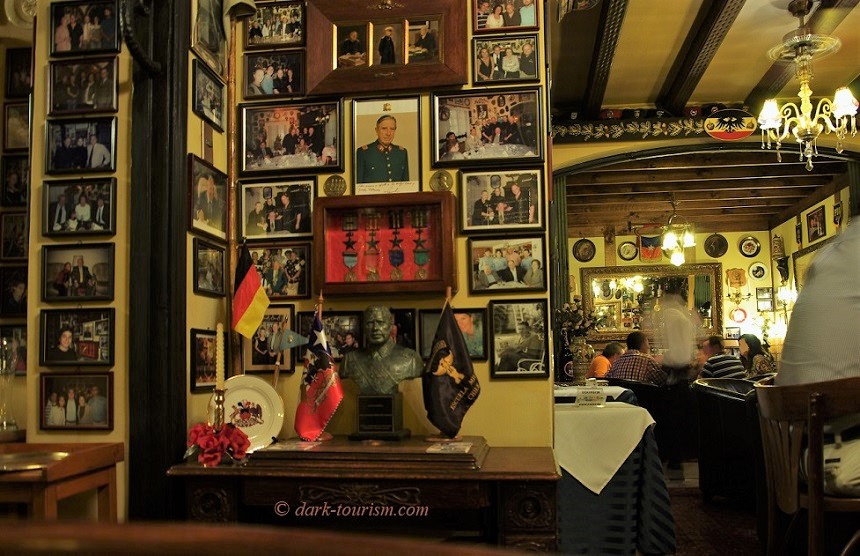
This photo was taken in the bar area of a German restaurant called “Lili Marleen”, located in Santiago de Chile (but now closed, going by a quick online check). I was more or less sent there on the orders (“as a German you absolutely have to go there”) of an American guy who had organized some tours for us in the city. I was forewarned that it had its dodgy sides, and indeed, amongst the various trinkets, family photos, decorative plates, portraits of German emperors, the Red Baron and whatnot, images of Pinochet were a recurrent leitmotif. In one corner, as seen in the above photo, there was even a veritable Pinochet “shrine”. Sitting at the bar, and with the benefit of a beer-loosened tongue (we’d already been to another bar before), I was able to chat (in German) with the owner a bit who was behind the bar pouring drinks, cleaning glasses and so on. It turned out that he was from the GDR (East Germany). And it was there that he developed a deep hatred of communism. When after the Fall of the Berlin Wall he went to Chile, he apparently was personally made welcome by the Pinochet family. So this shrine celebrates that family friendship (hence also the little German flag). I thought better of asking the owner what he thought of the coup and the brutal treatment of political prisoners during the Pinochet dictatorship, but I did venture asking him what he thought of Margot Honecker living in Santiago. Unsurprisingly he was very dismissive of her. (For those who don’t know: She was the influential wife of Erich Honecker, leader of the GDR from 1971 to 1989, and the pair eventually fled to Chile, where their daughter lived, and still lives – Erich died there in 1994, but his widow carried on unrepentantly celebrating the GDR until her own death in 2016. Only a few years before my trip to Chile in 2012, footage had emerged of Margot Honecker and a group of exiled diehard communists celebrating the 60th anniversary of the founding of the GDR and singing GDR-era patriotic songs …).
The next photo also shows a kind of cult-of-personality shrine inside a bar, this time it’s “The Pub” in Valletta, Malta:
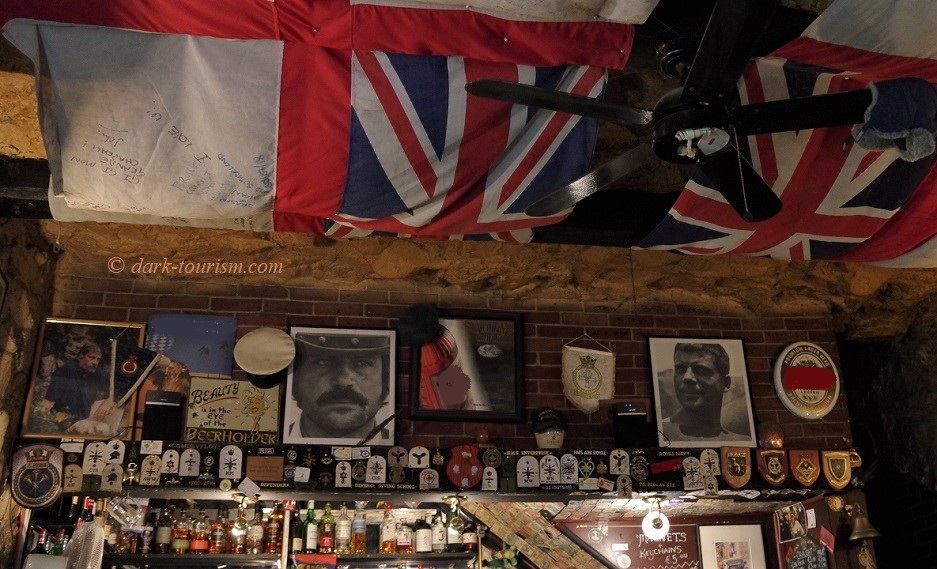
It was here that in 1999 English actor and well-known hellraiser Oliver Reed had his final drinks – in a binge session with some Royal Navy sailors – before he collapsed and died en route to the hospital. He had been in Malta for the filming of the movie “Gladiator”, which hence had to be finalized with the use of body doubles and CGI. At the pub you not only see various large photos of Reed, as well as some cartoons and artefacts, in addition to Navy flags hanging from the ceiling – the bar also sells a T-shirt that lists “Ollie’s Last Order” … and quite a list that is. His bar bill that day allegedly came to the equivalent of something like 500 euros.
For the next bar we go back to Svalbard, this time to Pyramiden:
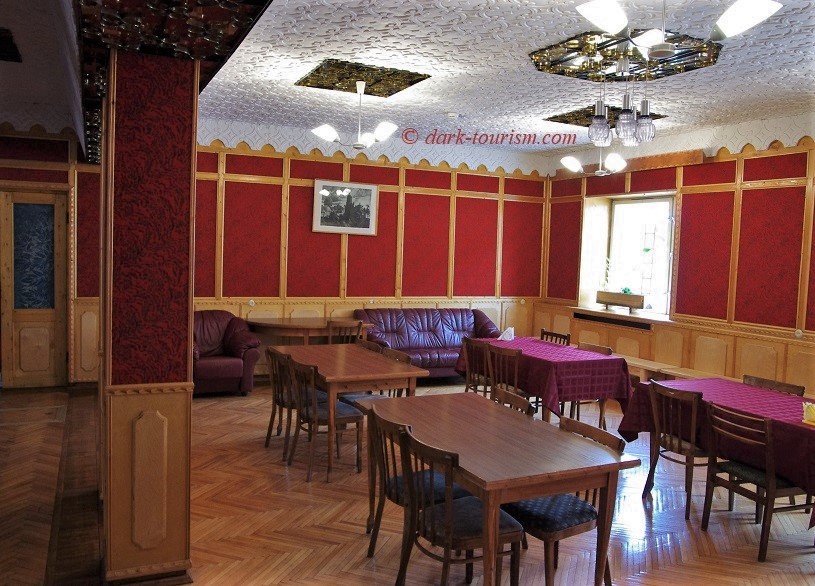
Pyramiden was another coal-mining outpost of the Soviet Union in this Norwegian territory, but, unlike Barentsburg, Pyramiden was closed down in 1998 after coal mining had become unprofitable and so the settlement became a ghost town, but is still under Russian lease. Since this Soviet-era time bubble became a visitor attraction of sorts, and various tours from Longyearbyen started being offered, the hotel in Pyramiden has been refurbished and is again open for overnight guests (only when there isn’t a pandemic, of course). And since a few staff live in Pyramiden again, a couple of them year-round, it’s strictly speaking not a full ghost town any longer.
Most visitors, though, come only on day trips by boat in the summer, and the guided tour of the ghost town typically ends at the hotel’s bar, where drinks are significantly cheaper than in Norway. This place in fact holds the record title of northernmost bar in the world – a sort of title that Pyramiden has several of, e.g. also the northernmost Lenin bust or the northernmost grand piano (both at the former cultural centre). One of the Russian staff also proudly showed me a small tomato plant – surely this, too, must be the northernmost of its kind.
And finally we come to a photo that combines both meanings of the word ‘bar’ in one frame:
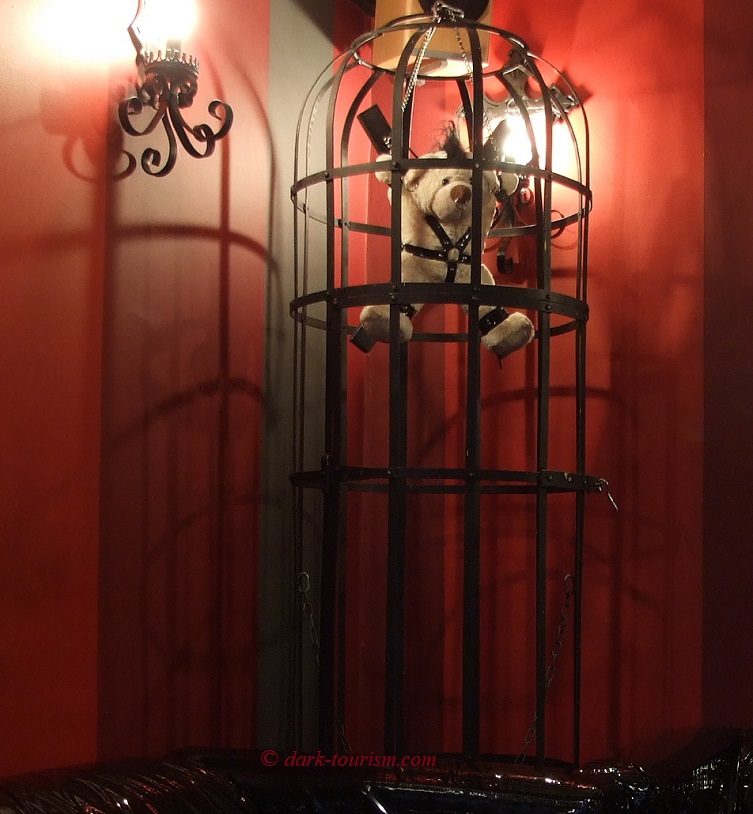
This was taken many years ago in a quirky S&M-themed bar in the middle of Budapest, Hungary. And amongst the various photos on the wall (you can guess the kind of images) and other decorations it also had this bondage teddy bear behind bars, in a cage. So this is bars inside a bar, as it were.
And that brings this somewhat unusual and at times a little tongue-in-cheek post to a worthy conclusion.



